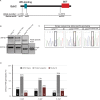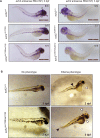The ezh2(sa1199) mutant zebrafish display no distinct phenotype
- PMID: 30677064
- PMCID: PMC6345456
- DOI: 10.1371/journal.pone.0210217
The ezh2(sa1199) mutant zebrafish display no distinct phenotype
Abstract
Polycomb group (PcG) proteins are essential regulators of epigenetic gene silencing and development. The PcG protein enhancer of zeste homolog 2 (Ezh2) is a key component of the Polycomb Repressive Complex 2 and is responsible for placing the histone H3 lysine 27 trimethylation (H3K27me3) repressive mark on the genome through its methyltransferase domain. Ezh2 is highly conserved in vertebrates. We studied the role of ezh2 during development of zebrafish with the use of a mutant allele (ezh2(sa1199), R18STOP), which has a stop mutation in the second exon of the ezh2 gene. Two versions of the same line were used during this study. The first and original version of zygotic ezh2(sa1199) mutants unexpectedly retained ezh2 expression in brain, gut, branchial arches, and eyes at 3 days post-fertilization (dpf), as revealed by in-situ hybridization. Moreover, the expression pattern in homozygous mutants was identical to that of wild types, indicating that mutant ezh2 mRNA is not subject to nonsense mediated decay (NMD) as predicted. Both wild type and ezh2 mutant embryos presented edemas at 2 and 3 dpf. The line was renewed by selective breeding to counter select the non-specific phenotypes and survival was assessed. In contrast to earlier studies on ezh2 mutant zebrafish, ezh2(sa1199) mutants survived until adulthood. Interestingly, the ezh2 mRNA and Ezh2 protein were present during adulthood (70 dpf) in both wild type and ezh2(sa1199) mutant zebrafish. We conclude that the ezh2(sa1199) allele does not exhibit an ezh2 loss-of-function phenotype.
Conflict of interest statement
The authors have declared that no competing interests exist.
Figures



References
Publication types
MeSH terms
Substances
Grants and funding
LinkOut - more resources
Full Text Sources
Molecular Biology Databases

